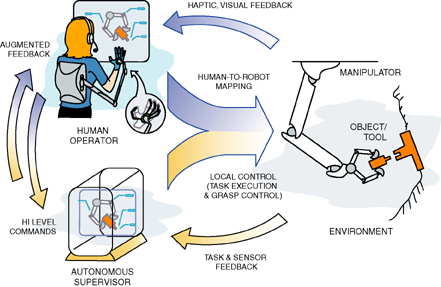

| |
| |
| |
| |
| |
The software framework for supervised dexterous control has recently been developed and implemented. The control software is based on methods from autonomous dexterous manipulation (see Okamura et al (2000) for an overview of dexterous manipulation). Building upon existing software, the robotic hand controller is capable of controlling the fingers individually (see Griffin et al (2000) for previous work), or in a coordinated fashion to impart desired forces or motions to an object. Utilizing the force and contact location sensors, the robotic hand is capable of grasp force regulation and impedance control of an object in hand. The transitions from individual fingertip control and cooperative control is based on sensor data and operator hand motions. This framework provides us with a platform for further investigation into supervised control and additional sensor integration and interpretation.
We have completed several preliminary experiments using the newly developed sensors and control software. The supervisory control framework was tested by having the operator grasp, manipulate, and release objects. These experiments allowed us to investigate suitable control parameters, mode transition methods, and sensor implementation.
The preliminary experiments in supervisory control have highlighted several difficulties due to the sharing of control between the operator and the semi-autonomous controller. One area that requires further investigation is how to accurately obtain the operatorís intent for grasp force. One approach is to command slave grasp forces based on the separation of operators fingers. However, this approach tends to destabilize the system unless we make the system very soft. An alternate approach maybe to use a combination of operator hand configuration and high level input such as voice commands. Another difficulty is determining the operatorís intention to release a grasped object during normal manipulation. We are currently approaching this problem from a theoretical stand point based on dexterous manipulation.
In creating a supervisory system we have moved our master-slave control system from a single computer to dedicated computers for both master and slave. In doing this, we have introduced time delays in to the telemanipulation control loop. As in typical telemanipulation system, the destabilizing effects of the time delays can be mitigated at the cost of reduced transparency (i.e., accurately recreating environmental impedance on the master side). We are investigating existing methods to optimize the system, as well as, looking at the possible benefits from a supervisory control framework.